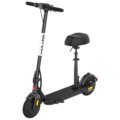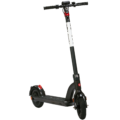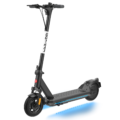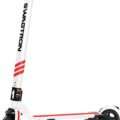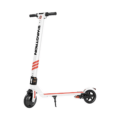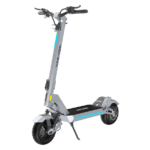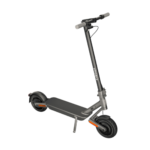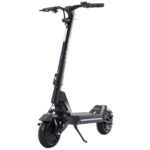- Home
- Scooters
- Electric Scooters
- Gotrax G3 MAX
Gotrax G3 MAX


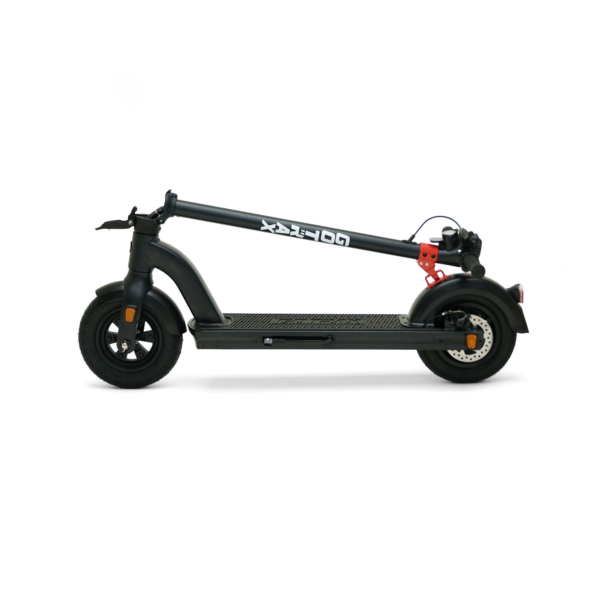

- Battery Range: 37 miles (60 km)
- Top Speed: 17 mph (27 km/h)
- Motor Power: 350 W
- Weight Capacity: 264 lbs (120 kg)
- Charging Time: ~5 hours
- Scooter Weight & Portability: ~43 lbs (19.5 kg)
PROS
- Excellent 37-mile real-world range
- Affordable price point
- Lightweight and easy to carry
- Integrated security with code lock and tiller cable
- Cruise control and clear display
CONS
- Limited top speed at 17 mph
- No suspension system
- Charging time (~5 hours) isn’t fast
Overview
Introduction: Why the G3 MAX Matters
The Gotrax G3 MAX Specifications highlight a scooter that aims to balance endurance, portability, and affordability in ways few commuter scooters manage. Where most entry-level scooters settle for 12–18 miles of range, the G3 MAX pushes that boundary with a claimed 37 miles per charge. This extended capacity reshapes how riders approach commuting, errands, and even casual adventures around the city.
Instead of focusing on raw speed, Gotrax designed the G3 MAX to be reliable and user-friendly. With a 350W rear-wheel motor, 10-inch pneumatic tires, and an integrated security system, it prioritizes dependability and daily convenience. At around 43 lbs, it remains light enough to carry into apartments, offices, or public transit when needed.
This review digs into every detail of the G3 MAX. We’ll explore its performance, comfort, safety, portability, and long-term ownership while comparing it to both other Gotrax scooters and competing models from rival brands. By the end, you’ll see why this scooter has become a favorite for commuters who value range and practicality.
Motor Power and Speed: A Steady Urban Performer
The Gotrax G3 MAX Specifications list a 350W motor positioned at the rear wheel. While this may not sound impressive compared to dual-motor performance scooters, it’s exactly what many urban riders need. The motor delivers 17 mph top speed, which keeps the scooter quick enough for bike lanes and city commuting, yet safe enough for new riders.
Acceleration feels smooth and predictable rather than jerky. That balance gives beginners confidence and prevents sudden surges that could throw off inexperienced riders. In dense city environments, 17 mph is often more than enough. At this pace, riders stay ahead of pedestrians and cyclists while keeping reaction times manageable in traffic.
When tackling hills, the G3 MAX performs adequately on moderate inclines. It may slow on steeper grades, especially with heavier riders, but it handles most urban slopes without difficulty. Because the motor sits at the rear, traction improves compared to front-wheel drive scooters. Riders feel more grounded, and the scooter accelerates more effectively from stops, even when carrying backpacks or groceries.
Battery Life and Real-World Range: Where It Excels
One of the biggest advantages of the Gotrax G3 MAX Specifications lies in its battery. Powered by a 48V 10.2Ah LG pack rated at 490Wh, it claims up to 37 miles of maximum range on a single charge. Few scooters under $600 can match this endurance.
In real-world riding, conditions vary. Riders who weigh close to the 264 lb limit and use full throttle consistently will likely achieve around 28–30 miles per charge. Lighter riders who use cruise control and ride at moderate speeds can come closer to 35 miles. Either way, the G3 MAX covers distances that most commuters only dream of.
Charging takes roughly 5 hours, which fits perfectly into a workday or overnight schedule. That balance between long range and reasonable recharge time makes the G3 MAX particularly appealing for professionals, students, or delivery riders who need reliability without constant downtime.
Comfort and Handling: A Smooth Ride for City Streets
Gotrax chose a simple yet effective setup for ride comfort. The scooter lacks suspension, but its 10-inch pneumatic tires compensate well. These air-filled tires absorb road vibrations, reducing the impact of cracks, cobblestones, and uneven asphalt. Riders accustomed to solid-tire scooters will immediately notice the smoother experience.
The deck offers enough width for comfortable foot placement, allowing riders to shift stance during longer rides. The handlebar height accommodates most adults comfortably, and the grips provide stability without causing hand fatigue. At 43 lbs, the scooter feels sturdy but not overwhelming, contributing to balanced handling.
Cruise control adds another layer of comfort. After maintaining speed for about 10 seconds, the scooter automatically locks in that pace. This feature reduces throttle fatigue, making longer commutes easier on the wrist. Combined with the long range, cruise control transforms daily rides into more relaxed journeys.
Safety Features: Built for Trust
The Gotrax G3 MAX Specifications include both mechanical and electronic braking systems. A rear disc brake offers strong mechanical stopping power, while the front electronic brake provides additional slowing force. This dual setup ensures riders can stop quickly and safely in traffic.
Lighting plays an important role in safety, and Gotrax equips the G3 MAX with a bright LED headlight and a responsive brake light at the rear. Reflective details further increase visibility at night. These features may seem basic, but they’re crucial for riders navigating city streets after dark.
Security is another strength. The G3 MAX comes with a built-in cable lock integrated into the tiller and a digital code lock. Together, they provide better theft deterrence than most scooters in its price range. For commuters who need to park outside shops or workplaces, this peace of mind makes a huge difference.
Portability and Storage: Balanced and Practical
At 43 lbs, the G3 MAX strikes a careful balance. It’s heavier than ultra-light scooters like the Gotrax XR Ultra, but much lighter than performance models exceeding 70 lbs. Most adults can carry it upstairs or lift it into a car trunk without much trouble.
The one-step folding mechanism simplifies transitions between riding and carrying. Folded, the scooter fits neatly in closets, office corners, or under desks. For apartment dwellers or students in dorms, this portability factor makes ownership much easier.
This mix of weight, folding, and compact design means the G3 MAX appeals to both solo riders and those mixing scooter travel with public transportation. It doesn’t overwhelm you with bulk, yet it still houses a large enough battery for extended journeys.
Daily Use Scenarios: Who the G3 MAX Fits
The Gotrax G3 MAX Specifications make it versatile enough for a wide range of daily uses:
- Commuters — Travel to and from work or school without worrying about recharging daily.
- Errand runners — Handle grocery trips or quick visits across town thanks to the extended range.
- Students — Enjoy a reliable scooter for getting around campus without paying for parking.
- Ride-share avoiders — Replace daily Uber or bus fares with predictable scooter ownership costs.
The scooter doesn’t suit thrill-seekers looking for 25–30 mph speeds or adventurers who want off-road capabilities. Instead, it thrives in urban cores and suburban areas where safety, convenience, and range matter more than raw performance.
Long-Term Ownership: Durability and Maintenance
Gotrax designed the G3 MAX for daily commuting, which means durability matters. The aluminum alloy frame resists wear and tear, and the pneumatic tires are easy to maintain with occasional inflation.
Owners report that the most common maintenance needs are brake adjustments and tire care. Because the scooter lacks suspension, tires bear most of the shock absorption. Checking them regularly for pressure and wear keeps rides smooth and prevents flats.
The LG battery cells add reliability. Unlike generic cells in some budget scooters, LG cells tend to hold charge better over long-term use. With proper charging habits—avoiding full drains and extreme temperatures—the G3 MAX battery can last several years.
Comparisons: G3 MAX vs Other Scooters
Compared to the Gotrax G3, which offers around 18 miles of range and a slightly weaker motor, the G3 MAX doubles endurance without becoming unwieldy. This improvement makes it far better for commuters with longer daily rides.
Against the Gotrax G4, the G3 MAX focuses more on range than speed. The G4 tops out at 20 mph but only offers 25 miles of range. Riders who prioritize endurance over pace will find the G3 MAX a smarter choice.
Stacked against premium models like the NIU KQi3 Max or Segway Ninebot MAX G2, the G3 MAX holds its ground. It offers similar or better range at a lower cost, though it lacks advanced app features and suspension systems. For value-focused buyers, that trade-off often feels worth it.
Safety Insights: Riding in Different Conditions
Riders often ask whether the G3 MAX works in various weather conditions. While it lacks a formal IP water resistance rating, anecdotal experiences suggest it handles light splashes without issue. However, like most scooters in its class, it should not be ridden in heavy rain.
At night, the scooter’s headlight provides enough brightness for city streets, but riders tackling darker suburban areas may want to add an external light. The integrated brake light, reflectors, and stability from pneumatic tires all contribute to a sense of security during evening rides.
Value for Money: Cost vs Benefits
At its price, the G3 MAX represents strong value. For under $600, riders receive:
- 37 miles of maximum range
- Integrated security features
- Cruise control and LED display
- Practical weight for portability
If you divide the purchase cost by the miles it covers, the G3 MAX delivers one of the best “cost-per-mile” values in its class. Over time, riders save significantly compared to paying for public transit or daily fuel expenses.
Final Verdict
The Gotrax G3 MAX Specifications make clear why it’s such a popular commuter choice. It may not reach high speeds or tackle steep hills like dual-motor machines, but it delivers where it matters most: range, portability, and practicality.
With its 37-mile battery, comfortable 10-inch pneumatic tires, built-in security, and cruise control, it redefines expectations for budget commuter scooters. Riders who want reliable transport that blends convenience and endurance will find the G3 MAX to be one of the best investments in its category.
Specifications
General
| Model The Model specifies the exact version or name of the scooter. It helps identify its unique design, features, and specifications within the manufacturer’s product line. Knowing the model makes it easier to compare options, find compatible accessories, or look up support information. | G3 MAX |
| Brand The Brand identifies the manufacturer or company that designs and produces the scooter. A trusted brand is a sign of quality, reliability, and good customer support. Well-known brands often have higher standards for safety, performance, and after-sales service, giving you more confidence in your purchase. | Gotrax |
| Release Date The Release Date indicates when the scooter model was officially launched on the market. This helps you know how current the design, technology, and features are. A newer release date often means updated components, improved performance, and the latest safety or smart features. | 01 January 2023 |
| Recommended Age Recommended Age indicates the minimum age range that the scooter is designed for, based on safety, size, and ease of use. Following the recommended age helps ensure that riders can handle the scooter’s speed, weight, and controls comfortably and safely. Always check local laws and use protective gear, especially for younger riders. | 16+ |
Performance & Power
| Motor Power (Wattage) What it means: The motor power, measured in watts (W), shows how strong the scooter’s electric motor is. Why it matters: Higher wattage usually means better acceleration, more torque, and improved performance on hills or rough terrain. For example, a 250W motor is good for flat city roads and light riders, while a 500W or 1000W motor provides more power for faster speeds or climbing steep inclines. | 350 W |
| Top Speed The Top Speed indicates the maximum speed that the scooter can reach under optimal conditions. It’s usually measured on level ground with a fully charged battery and an average rider weight. A higher top speed allows you to travel longer distances faster, but always ensure you ride within legal speed limits and your personal comfort zone for safety. | Up to 17 mph (27 km/h) |
| Battery Capacity Battery Capacity refers to the total amount of energy the scooter’s battery can store, usually measured in ampere-hours (Ah) or watt-hours (Wh). A higher battery capacity means you can ride longer distances on a single charge, reducing the need for frequent recharging. Keep in mind that actual range can vary depending on rider weight, terrain, speed, and weather conditions. | 48 V 10.2 Ah LG (490 Wh) |
| Estimated Range per Charge The Estimated Range per Charge indicates the average distance the scooter can travel on a single full battery charge. This range is calculated under optimal conditions, such as flat terrain, moderate speed, and average rider weight. Real-world range may vary depending on riding style, terrain, weather, and load. A longer range means fewer recharges and greater freedom for longer trips. | Up to 37 miles (60 km) |
| Hill Climb Ability Hill Climb Ability describes the maximum incline or slope that the scooter can handle while maintaining stable performance. It’s typically expressed as a percentage or in degrees. A higher hill climb rating means the scooter can tackle steeper hills without losing too much speed or power. Actual climbing performance may vary based on rider weight, battery charge, and terrain conditions. | Moderate, suitable for gentle grades |
| Drive System The Drive System refers to how power from the motor is delivered to the wheels. Electric scooters typically use either a hub motor (directly integrated into the wheel) or a chain/belt drive system. A high-quality drive system ensures smooth acceleration, efficient power transfer, and low maintenance. The choice of drive system affects performance, noise level, and overall ride experience. | Rear-wheel drive |
Charging & Electrical
| Charging Time Charging Time indicates how long it takes to fully recharge the scooter’s battery from empty to 100% using the standard charger provided. Faster charging means less downtime and more time on the road. Actual charging time may vary slightly depending on battery capacity, charger output, and environmental conditions. | ~5 hours (54.6 V, 2 A charger) |
| Battery Type Battery Type refers to the specific technology used in the scooter’s battery, which affects performance, lifespan, weight, and charging time. Most modern electric scooters use high-quality lithium-ion (Li-ion) batteries because they offer a good balance of energy density, durability, and low maintenance. A reliable battery type ensures consistent power delivery and longer riding ranges. | Lithium-ion |
| Removable Battery A Removable Battery means the battery pack can be easily detached from the scooter for convenient charging and replacement. This feature allows you to charge the battery separately, swap it with a spare for extended range, or securely store it indoors in extreme weather. Removable batteries add flexibility and make it easier to keep your scooter powered up wherever you are. | No |
| Regenerative Braking Regenerative Braking is an energy-saving feature that converts some of the energy normally lost during braking back into battery power. When you slow down or brake, the motor works in reverse to generate electricity, which helps extend the scooter’s range and improves overall efficiency. This system also reduces wear on traditional brake components, leading to lower maintenance over time. | Yes |
| Lighting Lighting refers to the built-in front and rear lights that enhance visibility and safety when riding in low-light conditions or at night. Good lighting helps you see the road ahead and ensures that other road users can see you. Many scooters include LED headlights, taillights, and sometimes brake lights or side reflectors for added safety and compliance with local traffic regulations. | LED headlight; tail and brake light (basic setup) |
Build & Dimensions
| Scooter Weight Scooter Weight refers to the total weight of the scooter when fully assembled, including the battery. This affects how easy it is to carry, lift, and store the scooter when not in use. A lighter scooter is more portable and convenient for commuting, especially if you need to carry it upstairs or onto public transport. Keep in mind that a sturdy frame and quality components may add to the weight but also contribute to better durability and ride stability. | ~43 lbs (19.5 kg) |
| Maximum Rider Weight Maximum Rider Weight indicates the highest rider weight that the scooter is designed to safely support while maintaining optimal performance and stability. Staying within this limit helps ensure reliable acceleration, braking, and climbing ability, and it protects the frame, suspension, and motor from excessive strain. Exceeding the recommended limit may reduce performance and increase wear on components. | 264 lbs (120 kg) |
| Deck Size Deck Size refers to the dimensions of the scooter’s standing platform. A wider and longer deck provides more foot space, allowing you to stand comfortably and adjust your stance while riding. A well-sized deck improves balance and stability, especially on longer rides or at higher speeds. Compact decks, on the other hand, help keep the scooter lightweight and portable. | ~6.7 in wide deck (reader note) |
| Handlebar Height Handlebar Height refers to the distance from the deck to the handlebars, which affects your riding posture and comfort. An appropriate handlebar height helps you maintain good balance, reduces strain on your back and arms, and makes steering more comfortable. Some scooters have adjustable handlebars to fit riders of different heights, while others have a fixed height for a streamlined design. | Standard commuter height (not specified) |
| Folding Mechanism The Folding Mechanism describes how easily and securely the scooter can be folded for carrying and storage. A well-designed folding system lets you quickly collapse the scooter into a compact size, making it convenient to transport on public transit, store under a desk, or fit into a car trunk. Look for sturdy latches and safety locks to ensure the scooter stays firmly in place when folded or unfolded. | Yes |
| Dimensions Folded Dimensions indicate the size of the scooter when it’s fully folded. This measurement shows how much space the scooter will take up when stored or carried, making it easier to check if it will fit in your car trunk, under a desk, or in a closet. Compact folded dimensions are ideal for commuters who need to bring their scooter on public transport or store it in tight spaces. | Compact for trunk storage |
| Material Material refers to the primary construction materials used for the scooter’s frame and key components. High-quality materials like aircraft-grade aluminum, reinforced steel, or durable composites provide strength, stability, and a lighter overall weight. A sturdy material ensures the scooter can handle daily wear and tear while maintaining safety and performance. | Aluminum alloy frame |
Safety & Control
| Brake Type(s) Brake Type(s) describe the braking systems the scooter uses to help you slow down or stop safely. Common brake types include mechanical brakes (like drum or disc brakes), electronic brakes, and foot brakes. Many scooters combine multiple braking systems for added safety and shorter stopping distances. The type and quality of brakes affect your control, especially when riding at higher speeds or on slopes. | Rear disc brake + electronic brake (front) |
| Suspension Suspension refers to the system that absorbs shocks and vibrations while riding, providing a smoother and more comfortable ride over uneven or rough surfaces. Scooters may have front suspension, rear suspension, or dual suspension for better shock absorption and stability. Good suspension helps reduce rider fatigue and improves control, especially when riding on bumpy roads or off-road paths. | None (relies on pneumatic tires) |
| Tire Type Tire Type refers to the kind of tires the scooter uses, which directly affects ride comfort, traction, and maintenance. Common types include solid (airless) tires, pneumatic (air-filled) tires, or hybrid options. Pneumatic tires offer better shock absorption and a smoother ride on rough surfaces, while solid tires are puncture-proof and require less upkeep. The right tire type helps ensure safe handling and a comfortable ride in different conditions. | 10″ pneumatic tires |
| Tire Size Tire Size indicates the diameter and width of the scooter’s tires, which affect ride comfort, stability, and how well the scooter handles different terrains. Larger tires generally offer better shock absorption and a smoother ride over bumps and rough surfaces, while smaller tires keep the scooter lighter and more portable. Choosing the right tire size helps ensure a balance between agility and comfort. | 10″ |
| Kickstand The Kickstand is a built-in stand that allows you to park your scooter upright when it’s not in use. A sturdy kickstand keeps the scooter stable and prevents it from tipping over, protecting it from scratches and damage. It also makes storing and accessing your scooter more convenient, whether you’re at home, work, or on the go. | Yes |
| Water Resistance Rating Water Resistance Rating indicates how well the scooter is protected against water and moisture, usually shown as an IP (Ingress Protection) rating. This rating helps you understand whether the scooter can handle light rain, splashes, or wet roads without damage. While most scooters are not fully waterproof, a good water resistance rating adds peace of mind when riding in changing weather conditions. Always avoid deep puddles or submerging the scooter to protect its electrical components. | Not specified (likely splash-resistant only) |
Features & Extras
| Display/Console The Display (or Console) shows important real-time information about your ride, helping you monitor your scooter’s status at a glance. Typical displays show speed, battery level, distance traveled, and riding mode. Some models also include additional features like Bluetooth connectivity, app integration, or backlighting for better visibility at night. A clear and easy-to-read display enhances safety and convenience on every trip. | LED display (speed, battery, mileage) |
| Ride Modes Ride Modes refer to the different speed and power settings you can choose to match your riding style or road conditions. Common modes include eco for maximum range and energy efficiency, standard for everyday balance, and sport or turbo for higher speed and stronger acceleration. Switching between ride modes allows you to customize performance, conserve battery, and ride safely in various environments. | Single mode only |
| Smart App Connectivity Smart App Connectivity lets you pair your scooter with a dedicated mobile app via Bluetooth. Using the app, you can monitor real-time ride stats like speed, battery level, and range, adjust settings such as ride modes or cruise control, lock the scooter for added security, and sometimes receive firmware updates. This feature adds convenience and allows you to personalize your riding experience right from your smartphone. | No |
| Anti-Theft System The Anti-Theft System helps protect your scooter from unauthorized use or theft. This feature can include built-in alarms, electronic motor locks, GPS tracking, or remote locking through a mobile app. A good anti-theft system provides peace of mind when parking your scooter in public spaces, adding an extra layer of security to safeguard your investment. | Integrated tiller cable lock and digital code safety lock |
| Cruise Control Cruise Control allows you to maintain a steady speed without continuously holding the throttle. This feature makes longer rides more comfortable by reducing hand fatigue and providing a smoother, more relaxed riding experience — especially on flat, open roads or bike lanes. For safety, cruise control can usually be easily activated or deactivated while riding. | Yes |
| Accessories Included Accessories Included lists the additional items that come with the scooter to enhance your riding experience and convenience. Common accessories may include a charger, kickstand, bell, lights, phone holder, or carrying strap. These extras add value by making your scooter safer, easier to use, and ready to ride straight out of the box. | Charger, toolkit, user manual |
Warranty & Compliance
| Warranty Period The Warranty Period indicates how long the manufacturer guarantees the scooter against defects in materials and workmanship under normal use. A good warranty provides peace of mind, showing the brand’s confidence in its product quality. Always check what parts are covered, such as the frame, battery, and motor, and follow the maintenance guidelines to keep your warranty valid. | 1 year limited |
| Certifications Certifications confirm that the scooter meets specific safety, quality, and environmental standards set by recognized organizations or regulatory bodies. Common certifications may include CE, RoHS, UL, or other local compliance marks, depending on your region. These certifications ensure that the scooter is manufactured to high standards and is safe and legal to use in your country. | UL2272 certified |


